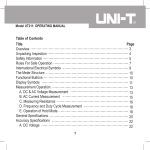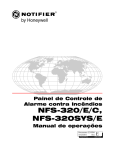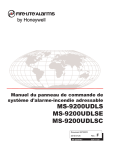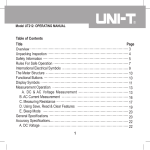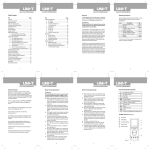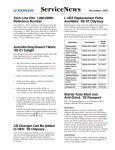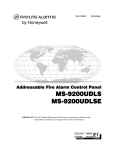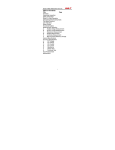Download UNI-T UT206A Specifications
Transcript
Certificate No. 956661 UT205/206 Operating Manual Digital Clamp Multimeter P/N : 4141030 Registered Design No.: 0011438.1M001 Model UT205/UT206: OPERATING MANUAL Table of Contents Title Overview Unpacking Inspection Safety Information Rules For Safe Operation International Electrical Symbols The Meter Structure Rotary Switch Functional Buttons Display Symbols Measurement Operation A. DC Voltage Measurement B. AC Voltage Measurement C. Measuring Resistance D. Testing for Continuity E. Testing Diodes F. Capacitance Measurement G. Frequency Measurement H. Measuring Duty Cycle I. Temperature Measurement (Model UT206) J. AC Current Measurement Operation of Hold Mode The Use of Relative Value Mode The BLUE Button Turning on the Display Backlight Sleep Mode General Specifications Accuracy Specifications A. DC Voltage B. AC Voltage C. Resistance D. Continuity Test E. Diode Test F. Capacitance G. Frequency & Duty Cycle H. Temperature (Model UT206) I. AC Current Maintenance A. General Service B. Replacing the Battery Page p. p. p. p. p. p. p. p. p. p. p. p. p. p. p. p. p. p. p. p. p. p. p. p. p. p. p. p. p. p. p. p. p. p. p. p. p. p. p. 2 3 4 5~6 6 7 8 9~10 11~12 13~22 13 14 15 16 17 18 19 20 21 22 23 23 24 24 24 25 26~28 26 26 26 27 27 27 28 28 28 29 29 29 1 Model UT205/UT206: OPERATING MANUAL Overview This Operating Manual covers information on safety and cautions. Please read the relevant information carefully and observe all the Warnings and Notes strictly. Warning To avoid electric shock or personal injury, read the “Safety Information” and “Rules for Safe Operation” carefully before using the Meter. The Model UT205 and UT206 (hereafter referred to as “the Meter”) are 4000 counts, 3 3/4 digits hand-held digital auto ranging clamp multimeters with stabilize functions, safety operations, and reliable performance. In addition to the conventional measuring functions, there is a unique jaw opening light and display backlight features enabling user to work in a dim condition. This is also a highly applied digital clamp multimeter of good performance with full overload protection and sleep mode. The Model UT206 also has temperature measurement function. Except where noted, the descriptions and instructions in this Operating Manual apply to both the Model UT205/UT206. 2 Model UT205/UT206: OPERATING MANUAL Unpacking Inspection Open the package case and take out the Meter. Check the following items carefully to see any missing or damaged part: Item 1 2 3 4 5 6 7 Description Operating Manual Test Lead Test Clip Model UT206: Point Contact Temperature Probe 9V Battery (NEDA 1604, 6F22 or 006P) (installed) 1.5V Battery (AAA) (installed) Vinyl Bag 1 1 1 1 Qty piece pair pair piece 1 piece 1 piece 1 piece In the event you find any missing or damage, please contact your dealer immediately. 3 Model UT205/UT206: OPERATING MANUAL Safety Information This Meter complies with the standards IEC61010: in pollution degree 2, overvoltage category (CAT. III 600V) and double insulation. CAT. III: Distribution level, fixed installation, with smaller transient overvoltages than CAT. IV Use the Meter only as specified in this operating manual, otherwise the protection provided by the Meter may be impaired. In this manual, a Warning identifies conditions and actions that pose hazards to the user, or may damage the Meter or the equipment under test. A Note identifies the information that user should pay attention on. International electrical symbols used on the Meter and in this Operating Manual are explained on page 6. 4 Model UT205/UT206: OPERATING MANUAL Rules For Safe Operation (1) Warning To avoid possible electric shock or personal injury, and to avoid possible damage to the Meter or to the equipment under test, adhere to the following rules: • Never measure current while the test leads are inserted into the input terminals. • Before using the Meter inspect the case. Do not use the Meter if it is damaged or the case (or part of the case) is removed. Look for cracks or missing plastic. Pay attention to the insulation around the connectors. • Inspect the test leads for damaged insulation or exposed metal. Check the test leads for continuity. Replace damaged test leads with identical model number or electrical specifications before using the Meter. • Do not apply more than the rated voltage, as marked on the Meter, between the terminals or between any terminal and grounding. • The rotary switch should be placed in the right position and no any changeover of range shall be made during measurement is conducted to prevent damage of the Meter. • When the Meter working at an effective voltage over 60V in DC or 30V rms in AC, special care should be taken for there is danger of electric shock. • Use the proper terminals, function, and range for your measurements. • Do not use or store the Meter in an environment of high temperature, humidity, explosive, inflammable and strong magnetic field. The performance of the Meter may deteriorate after dampened. • When using the test leads, keep your fingers behind the finger guards. • Disconnect circuit power and discharge all highvoltage capacitors before testing resistance, continuity, diodes, or capacitance. • Replace the battery as soon as the battery indicator appears. With a low battery, the Meter might produce false readings that can lead to electric shock and personal injury. 5 Model UT205/UT206: OPERATING MANUAL Rules For Safe Operation (2) • Remove test leads, temperature probe and test clip from the Meter and turn the Meter power off before opening the Meter case. • When servicing the Meter, use only the same model number or identical electrical specifications replacement parts. • The internal circuit of the Meter shall not be altered at will to avoid damage of the Meter and any accident. • Soft cloth and mild detergent should be used to clean the surface of the Meter when servicing. No abrasive and solvent should be used to prevent the surface of the Meter from corrosion, damage and accident. • The Meter is suitable for indoor use. International Electrical Symbols AC (Alternating Current) DC (Direct Current) AC or DC Deficiency of Built-In Battery Continuity Test Diode Grounding Capacitance Test Double Insulated Warning. Refer to the Operating Manual Conforms to Standards of European Union 6 Model UT205/UT206: OPERATING MANUAL The Meter Structure (See figure 1) Transformer Jaws designed to pick up the AC current flowing through the conductor. The Jaw Opening Light. HOLD button. LCD Display. Function Button. V Input Terminal: Input for voltage measurement. COM Input Terminal: Return terminal for all measurements. HzΩ: Model UT205: Input for capacitance, continuity, diode, frequency/duty cycle and resistance measurements. Model UT206: Input for capacitance, continuity, diode, frequency/duty cycle, resistance and temperature measurements. Rotary Switch. Trigger. Press the lever to open the transformer jaws and turn the jaw opening light on. When the pressure on the lever is released, the jaws will close and the light will off again. 7 Model UT205/UT206: OPERATING MANUAL Rotary Switch Below table indicated for information about the rotary switch positions. Rotary Switch Position Function OFF Turn on or off the Meter. V AC voltage measurement range from 4.000V to 600.0V or DC voltage measurement range from 400.0mV to 600.0V V Model UT206: DC voltage measurement range from 400.0mV to 600.0V V Model UT206: AC voltage measurement range from 4.000V to 600.0V Ω Continuity test Ω Resistance measurement range from 400.0Ω to 40.00MΩ Diode test Capacitance test range from 4.000nF to 200.0µF ˚C Model UT206: Temperature in celsius from -40˚C ~ 1000˚C Hz Frequency measurement range from 10.00Hz to 10.00MHz 1000A AC current measurement range 400.0A to 1000A 8 Model UT205/UT206: OPERATING MANUAL Functional Buttons (1) Below table indicated for information about the functional button operations. Measuring Operation Performed Function Any rotary Turn the display backlight on and off. switch (Yellow) position Hz Hz 1. Press to start the frequency counter; the Meter beeps. 2. Press again to enter duty cycle mode; the Meter beeps. 3. Press again to return to the frequency counter mode; the Meter beeps. V , 1. Press to start the frequency counter, V , the range is between 1Hz ~1kHz; the V or Meter beeps. 1000A 2. Press again to enter duty cycle mode; the Meter beeps. 3. Press again to return voltage or current mode; the Meter beeps. REL∆ Any rotary Press REL∆ to enter and exit the switch REL mode in any measuring mode position except in frequency/duty cycle, diode except Hz, and continuity; the Meter beeps. , Button 9 Model UT205/UT206: OPERATING MANUAL Functional Buttons (2) Measuring Operation Performed Function V Switches between DC and AC voltage; the Meter beeps. DC voltage is (Blue) default. Model UT205: Switches between diode and continuity measurements; the Meter beeps. Diode is default. Ω Model UT206: Switches between resistance and diode and continuity and capacitance measurements; the Meter beeps. Resistance is default. HOLD Any rotary Press HOLD to enter and exit the switch Hold mode in any mode, the Meter position beeps. Button 10 Model UT205/UT206: OPERATING MANUAL Display Symbols (1) (See figure 2) ∆ Symbol Meaning AC Indicator for AC voltage or current. The displayed value is the mean value. DC Indicator for DC voltage. The displayed value is the mean value. AUTO The Meter is in the auto range mode in which the Meter automatically selects the range with the best resolution. % Percent: Used for duty cycle measurements. Data hold is active. The relative value mode is on to ∆ display the stored value minus the present The battery is low. ˚C Warning To avoid false readings, which could lead to possible electric shock or personal injury, replace the battery as soon as the battery indicator appears. Centigrade. The unit of temperature. Test of diode The continuity buzzer is on. 11 Model UT205/UT206: OPERATING MANUAL Display Symbols (2) (See figure 2) Number 12 Symbol Meaning Ω, kΩ, Ω: Ohm. The unit of resistance. MΩ kΩ: kilohm. 1 x 103 or 1000 ohms. MΩ: Megaohm. 1 x 106 or 1,000,000 ohms. F, µF, F: Farad. The unit of capacitance. nF µF: Microfarad. 1 x 10-6 or 0.000001 farads. nF: Nanofarad. 1 x 10-9 or 0.000000001 farads. Hz, kHz, Hz: Hertz. The unit of frequency. Mhz kHz: Kilohertz. 1 x 103 or 1000 hertz. MHz:Megahertz. 1 x 106 or 1,000,000 hertz. V, mV V: Volts. The unit of voltage. mV: Millivolt. 1 x 10-3 or 0.001 volts. A, mA, A: Amperes (amps). µA The unit of current. mA: Milliamp. 1 x 10-3 or 0.001 amperes. µA: Microamp. 1x 10-6 or 0.000001 amperes. Indicates negative reading. The input value is too large for the selected range. Model UT205/UT206: OPERATING MANUAL Measurement Operation (1) A. DC Voltage Measurement (See figure 3) red black red black Warning To avoid harms to you or damages to the Meter from electric shock, please do not attempt to measure voltages higher than 600V / 600V rms although readings may be obtained. The DC Voltage ranges are: 400.0mV, 4.000V, 40.00V, 400.0V and 600.0V. To measure DC voltage, connect the Meter as follows: 1. Insert the red test lead into the V terminal and the black test lead into the COM terminal. ; DC measurement 2. Model UT205: Set the rotary switch to V is default or press BLUE button to select DC measurement mode. Model UT206: Set the rotary switch to V 3. Connect the test leads across with the object being measured. The measured value shows on the display. Note • In each range, the Meter has an input impedance of 10M . This loading effect can cause measurement errors in high impedance circuits. If the circuit impedance is less than or equal to 10k , the error is negligible (0.1% or less). • When DC voltage measurement has been completed, disconnect the connection between the testing leads and the circuit under test, and remove the testing leads away from the input terminals of the Meter. 13 Model UT205/UT206: OPERATING MANUAL Measurement Operation (2) B. AC Voltage Measurement (See figure 4) red black black red Warning To avoid harms to you or damages to the Meter from electric shock, please do not attempt to measure voltages higher than 600V / 600V rms although readings may be obtained. The AC voltage ranges are: 4.000V, 40.00V, 400.0V and 600.0V. To measure AC Voltage, connect the Meter as follows: 1. Insert the red test lead into the V terminal and the black test lead into the COM terminal. 2. Model UT205: Set the rotary switch to V and press BLUE button to select AC measurement mode. Model UT206: Set the rotary switch to V . 3. Connect the test leads across with the object being measured. The measured value shows on the display. Note • In each range, the Meter has an input impedance of 10M . This loading effect can cause measurement errors in high impedance circuits. If the circuit impedance is less than or equal to 10k , the error is negligible (0.1% or less). • When AC voltage measurement has been completed, disconnect the connection between the testing leads and the circuit under test, and remove the testing leads away from the input terminals of the Meter. • Root mean square value stability period: When the reading obtained is less than 100 digits, the root mean square value converter needs a longer time to stabilize. When there is no input voltage, the maximum reading displayed is 10 digits. 14 Model UT205/UT206: OPERATING MANUAL Measurement Operation (3) C. Measuring Resistance (See figure 5) black red black red Warning To avoid damages to the Meter or to the devices under test, disconnect circuit power and discharge all the high-voltage capacitors before measuring resistance. The resistance ranges are: 400.0Ω , 4.000kΩ , 40.00kΩ , 400.0kΩ , 4.000MΩ and 40.00MΩ . To measure resistance, connect the Meter as follows: 1. Insert the red test lead into the HzΩ terminal and the black test lead into the COM terminal. 2. Model UT205: Set the rotary switch to Ω. , resistance Model UT206: Set the rotary switch to Ω measurement (Ω) is default or press BLUE button to select Ω measurement mode. 3. Connect the test leads across with the object being measured. The measured value shows on the display. Note • The test leads can add 0.1Ω to 0.2Ω of error to resistance measurement. To obtain precision readings in low-resistance measurement, that is the range of 400.0Ω , short-circuit the input terminals beforehand, using the relative measurement function button REL∆ to automatically subtract the value measured when the testing leads are short-circuited from the reading. • If Ω reading with shorted test leads is not ≤0.5Ω , check for loose test leads, incorrect function selection, or enabled Data Hold function. • For high-resistance measurement (>1MΩ ), it is normal to take several seconds to obtain a stable reading. • The LCD displays indicating open-circuit for the tested resistor or the resistor value is higher than the maximum range of the Meter. 15 Model UT205/UT206: OPERATING MANUAL Measurement Operation (4) • When resistance measurement has been completed, disconnect the connection between the testing leads and the circuit under test, and remove the testing leads away from the input terminals of the Meter. D. Testing for Continuity (See figure 6) black red Warning To avoid damages to the Meter or to the devices under test, disconnect circuit power and discharge all the high-voltage capacitors before testing for continuity. To test for continuity, connect the Meter as below: 1. Insert the red test lead into the HzΩ terminal and the black test lead into the COM terminal. and press BLUE 2. Model UT205: Set the rotary switch to button to select measurement mode. Model UT206: Set the rotary switch to Ω and press BLUE button to select measurement mode. 3. The buzzer sounds if the resistance of a circuit under test is less than around 70Ω. Note indicating the circuit being tested is open. • The LCD displays • When continuity testing has been completed, disconnect the connection between the testing leads and the circuit under test, and remove the testing leads away from the input terminals of the Meter. 16 Model UT205/UT206: OPERATING MANUAL Measurement Operation (5) E. Testing Diodes (See figure 7) black red Warning To avoid possible damage to the Meter and to the device under test, disconnect circuit power and discharge all high-voltage capacitors before testing diodes. Use the diode test to check diodes, transistors, and other semiconductor devices. The diode test sends a current through the semiconductor junction, and then measures the voltage drop across the junction. A good silicon junction drops between 0.5V and 0.8V. To test a diode out of a circuit, connect the Meter as follows: 1. Insert the red test lead into the HzΩ terminal and the black test lead into the COM terminal. , diode measurement 2. Model UT205: Set the rotary switch to ( ) is default or press BLUE button to select measurement mode. Model UT206: Set the rotary switch to Ω and press BLUE measurement mode. button to select 3. For forward voltage drop readings on any semiconductor component, place the red test lead on the component's anode and place the black test lead on the component's cathode. The measured value shows on the display. Note • In a circuit, a good diode should still produce a forward voltage drop reading of 0.5V to 0.8V; however, the reverse-voltage drop reading can vary depending on the resistance of other pathways between the probe tips. • Connect the test leads to the proper terminals as said above to avoid error display. The LCD will display indicating diode being tested is open or polarity is reversed. The unit of diode is Volt (V), displaying the forward voltage drop readings. 17 Model UT205/UT206: OPERATING MANUAL Measurement Operation (6) • When diode testing has been completed, disconnect the connection between the testing leads and the circuit under test, and remove the testing leads away from the input terminals of the Meter. F. Capacitance Measurement (See figure 8) black red black red Warning To avoid damage to the Meter or to the equipment under test, disconnect circuit power and discharge all high-voltage capacitors before measuring capacitance. Use the DC Voltage function to confirm that the capacitor is discharged. The Meter's capacitance ranges are: 4.000nF, 40.00nF, 400.0nF, 4.000µF, 40.00µF, and 200.0µF. To measure capacitance, connect the Meter as follows: 1. Insert the red test lead into the HzΩ terminal and the black test lead into the COM terminal. 2. Model UT205: Set the rotary switch to . and press BLUE Model UT206: Set the rotary switch to Ω button to select measurement mode. 3. Connect the test leads across with the object being measured. The measured value shows on the display. Note • For testing the capacitor with polarity, connect the red clip to anode & black clip to cathode instead of test leads as mentioned above. • To minimize the effect of capacitance stored in the test leads, the test lead should be as short as possible. To measure a small value of capacitor, use REL mode to remove the test leads capacitance. Remaining voltage, insulated impedance, & dielectric absorption from the capacitor may cause the measurement error. • It takes a longer time when testing a high capacitor value. The testing time is around 30 seconds in 200µF range. 18 Model UT205/UT206: OPERATING MANUAL Measurement Operation (7) • The LCD displays indicating the tested capacitor is shorted or it exceeds the maximum range. • When capacitance measurement has been completed, disconnect the connection between the testing leads and the circuit under test and remove the testing leads away from the input terminals of the Meter. G. Frequency Measurement (See figure 9) black red The measurement range is from 10Hz, 100Hz, 1kHz, 10kHz, 100kHz, 1MHz and 10MHz. To measure frequency, connect the Meter as follows: 1. Insert the red test lead into the HzΩ terminal and the black test lead into the COM terminal. 2. Set the rotary switch to Hz; frequency measurement (Hz) is default or press Hz button to select Hz measurement mode. 3. Connect the test leads across with the object being measured. The measured value shows on the display. Note • When frequency measurement has been completed, disconnect the connection between the testing leads and the circuit under test, and remove the testing leads away from the input terminals of the Meter. • When making frequency measurement at voltage or current range, please mind the following signal requirement table: Range 400mV 4V 40V 400V 600V 1000A Signal Requirement ≥ 100mV ≥ 0.45V ≥ 4.5V ≥ 45V ≥ 450V ≥ 450A Frequency Range 1Hz~1kHz 1Hz~1kHz 1Hz~1kHz 1Hz~1kHz 1Hz~200Hz 45Hz~65Hz 19 Model UT205/UT206: OPERATING MANUAL Measurement Operation (8) H. Measuring Duty Cycle (See figure 10) black red The duty cycle measurement range is: 0.1%~99.9%. To measure duty cycle, do the following: 1. Set up the Meter to measure frequency. 2. To select duty cycle, press Hz until the % symbol is shown on the display. 3. Connect the test leads across with the object being measured. The measured value shows on the display. Note • The LCD displays 000.0% indicating the input signal is high or low level. • When duty cycle measurement has been completed, disconnect the connection between the testing leads and the circuit under test, and remove the testing leads away from the input terminals of the Meter. 20 Model UT205/UT206: OPERATING MANUAL Measurement Operation (9) I. Model UT206: Temperature Measurement (See figure 11) The temperature measurement range is -40˚C~1000˚C. To measure temperature, connect the Meter as follows: HzΩ terminal 1. Insert the red temperature probe into the and the black temperature probe into the COM terminal. 2. Set the rotary switch to ˚C. 3. Place the temperature probe to the object being measured. The measured value shows on the display. Note • The Meter automatically displays the temperature value inside the Meter when there is no temperature probe connection. • The included point contact temperature probe can only be used up to 250˚C. For any measurement higher than that, the rod type temperature probe must be used instead. • When temperature measurement has been completed, disconnect the connection between the testing leads and the circuit under test, and remove the testing leads away from the input terminals of the Meter. 21 Model UT205/UT206: OPERATING MANUAL Measurement Operation (10) J. AC Current Measurement (See figure 12) Warning To avoid electric shock, never measure current while the test leads are inserted into the input terminals and disconnect test leads and tested circuit connection. Never attempt an in-circuit current measurement where the opencircuit voltage between the circuit and ground is greater than 600V. Use proper function, and range for the measurement. The measurement ranges of current are: 400.0A and 1000A. To measure current, do the following: 1. Set the rotary switch to 1000A . 2. Press the lever to open the transformer jaws. 3. Center the conductor within the transformer jaw. The measured value shows on the display, it is a effective value of sine wave (mean value response). Note • When current measurement has been completed, disconnect the connection between the conductor under test and the jaw, and remove the conductor away from the transformer jaw of the Meter. 22 Model UT205/UT206: OPERATING MANUAL Operation of Hold Mode Warning To avoid possibility of electric shock, do not use Hold mode to determine if circuits are without power. The Hold mode will not capture unstable or noisy readings. The Hold mode is applicable to all measurement functions. • Press HOLD to enter Hold mode; the Meter beeps. • Press HOLD again or turn the rotary switch to exit Hold mode; the Meter beeps. • In Hold mode, is displayed. The Use of Relative Value Mode The REL mode applies to all measurement functions except frequency/duty cycle, diode and continuity measurement. It subtracts a stored value from the present measurement value and displays the result. For instance, if the stored value is 20.0V and the present measurement value is 22.0V, the reading would be 2.0V. If a new measurement value is equal to the stored value then display 0.0V. To enter or exit REL mode: • Use rotary switch to select the measurement function before selecting REL∆. If measurement function changes manually after REL∆ is selected, the Meter exits the REL mode. • Press REL∆ to enter REL mode, auto ranging turns off except under capacitance testing mode, and the present measurement range is locked and display ‘0’ as the stored value. • Press REL∆ again or turn the rotary switch to reset the stored value and exit REL mode. Pressing HOLD in REL mode makes the Meter stop updating. Pressing HOLD again to resume updating. 23 Model UT205/UT206: OPERATING MANUAL The BLUE button It uses for selecting the required measurement function when there is more than one function at one position of the rotary switch. Turning on the Display Backlight Warning In order to avoid the hazard arising from mistaken readings in insufficient light or poor vision, please use Display Backlight function. • Press and hold YELLOW button for over 2 seconds to turn the Display Backlight on. • Press YELLOW button again to turn the Display Backlight off, otherwise it will stay on continuously. Sleep Mode To preserve battery life, the Meter automatically turns off if you do not turn the rotary switch or press any button for around 15 minutes. The Meter can be activated by turning the rotary switch or pressing the YELLOW, Hz or REL∆ button, it will display the present measurement value. To disable the Sleep Mode function, press BLUE button while turning on the Meter. 24 Model UT205/UT206: OPERATING MANUAL General Specifications Max. Voltage 600V rms. between any Terminals and Grounding: Max. Current 1000A AC rms continuous. Measurement of Transformer Jaw: Max. Jaw Size: 40mm. Max. Display: Digital: 3999 Measurement Speed: Updates 3 times/second. Temperature: Operating: 5˚C to +35˚C (41˚F to +95˚F). Storage: -10˚C to +50˚C (14˚F to +122˚F). Relative Humidity: ≤75% @ 0 - 30˚C ; ≤50% @ 31˚C - 40˚C. Altitude: Operating: 2000 m. Storage: 10000 m. Battery Type: The Meter: One piece of 9V (NEDA1604 or 6F22 or 006P). The Jaw Opening Light: One piece of 1.5V (AAA) Battery Deficiency: Display Dimensions (HxWxL): 260 x 104 x 52 mm. Weight: Approximate 530g (battery included). Safety/Compliances: IEC61010 CAT. III 600V overvoltage and double insulation standard. Certifications: , (UL/CUL pending) 25 Model UT205/UT206: OPERATING MANUAL Accuracy Specifications (1) Accuracy: ± (a% reading + b digits), guarantee for 1 year. Operating temperature 23˚C±5˚C. Relative humidity <75%. Temperature coefficient: 0.1 x (specified accuracy)/ 1˚C. A. DC Voltage Range Resolution Accuracy Overload Protection 400mV 100µV ±(0.8%+3) 4V 1mV 600V DC 40V 10mV ±(0.8%+1) 600V AC rms 400V 100mV continuous. 600V 1V ±(1%+3) Remarks: Input impedance ≥10MΩ. B. AC Voltage Range Resolution Accuracy Overload Protection 4V 1mV 600V DC 40V 10mV ±(1.2%+5) 600V AC rms 400V 100mV continuous 600V 1V ±(1.5%+5) Remarks: • Input impedance ≥10MΩ. • Displays effective value of sine wave (mean value response). • Frequency response: When <400V: 40Hz~400Hz; When ≥400V: 40Hz~100Hz C. Resistance Range Resolution 400Ω 0.1Ω 4kΩ 1Ω 40kΩ 10Ω 400kΩ 100Ω 4MΩ 1kΩ 40MΩ 10kΩ Remarks: Open circuit 26 Accuracy Overload Protection ±(1.2%+2) ±(1%+2) 600Vp ±(1.2%+2) ±(1.5%+2) voltage approximate 0.45V. Model UT205/UT206: OPERATING MANUAL Accuracy Specifications (2) D. Continuity Test Range Resolution 400.0Ω 0.1Ω Accuracy Overload Protection 600Vp Approximate <70Ω Remarks: • Buzzer beeps continuous. • Open circuit voltage approximate 0.45V. E. Diode Test Range Resolution Overload Protection Diode 1mV 600Vp Remarks: • Open circuit voltage approximate 1.48V. • Displays approximate forward voltage drop: 0.5V~0.8V. F. Capacitance Range 4nF Resolution 1pF 40nF 400nF 4µF 40µF 200µF 10pF 100pF 1nF 10nF 100nF Overload Protection Accuracy Measure at REL mode ±(5%+40) 600Vp ±(3%+5) ±(4%+10) Remarks: • 40nF~200µF: Reading < 1nF is only for reference purpose. 27 Model UT205/UT206: OPERATING MANUAL Accuracy Specifications (3) G. Frequency & Duty Cycle Range Resolution Accuracy Overload Protection 10Hz 0.001Hz 100Hz 0.01Hz 1kHz 0.1Hz 10kHz 1Hz ±(0.1%+3) 600Vp 100kHz 10Hz 1MHz 100Hz 10MHz 1kHz 0.1% 0.01% ~99.9% Remarks: • 10Hz~10MHz Range: Input sensitivity as follows: ≤1MHz: ≤300mV rms; >1MHz: ≤600mV rms. • 0.1% ~ 99.9%: Reading is only for reference purpose. H. Temperature (Model UT206) Range Resolution -40˚C~1000˚C 1˚C Accuracy -40˚C~0˚C ±(3%+4) 0˚C~400˚C ±(1%+3) 400˚C~1000˚C ±(2%+10) Input Protection: 600Vp I. AC Current Range Resolution Overload Protection Accuracy 400A 0.1A 1000A AC rms ±(1.5%+5) 1000A 1A continuous ≤800A: ±(2%+5) >800A: ±(3%+5) Remarks: • Frequency response 50Hz~60Hz. • Display effective value of sine wave (mean value response) 28 Model UT205/UT206: OPERATING MANUAL MAINTENANCE This section provides basic maintenance information including battery replacement instruction. Warning Do not attempt to repair or service your Meter unless you are qualified to do so and have the relevant calibration, performance test, and service information. To avoid electrical shock or damage to the Meter, do you get water inside the case. A. General Service • Periodically wipe the case with a damp cloth and mild detergent. Do not use abrasives or solvents. • To clean the terminals with cotton bar with detergent, as dirt or moisture in the terminals can affect readings. • Turn the Meter to OFF position when it is not in use. • Take out the battery when it is not using for a long time. • Do not use or store the Meter in a place of humidity, high temperature, explosive, inflammable and strong magnetic field. B. Replacing the Battery Warning To avoid false readings, which could lead to possible electric shock or personal injury, replace the battery as soon as the battery indicator “ ” appears. Make sure the transformer jaw and the test leads are disconnected from the circuit being tested before opening the case bottom. Make sure the test leads are removed from the input terminals. To replace the battery: 1. Turn the rotary switch of the Meter to OFF position and remove all the connections from the terminals. 2. Remove the screw from the battery compartment, and separate the battery compartment from the case bottom. 3. Remove the battery from the battery compartment. 4. Replace the battery with a new 9V battery (NEDA1604, 6F22 or 006P) and or a 1.5V battery (AAA). 5. Rejoin the case bottom and battery compartment, and reinstall the screw. 29 Model UT205/UT206: OPERATING MANUAL ~ END ~ This operating manual is subject to change without notice. © Copyright 2001 Uni-Trend International Limited. All rights reserved. 30 Model UT205/UT206: OPERATING MANUAL 31 Model UT205/UT206: OPERATING MANUAL Manufacturer: Uni-Trend International Limited Rm901, 9/F, Nanyang Plaza 57 Hung To Road, Kwun Tong Kowloon, Hong Kong Tel.: (852) 2950 9168 Fax.: (852) 2950 9303 Email: [email protected] http://www.uni-trend.com 32

































